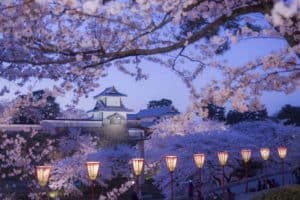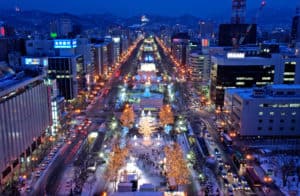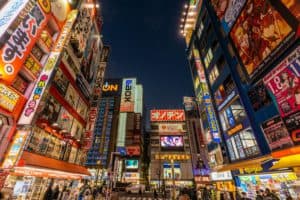
-
Fushimi Inari Taisha
An important shrine dedicated to Inari, the Shinto god of rice, commerce and business. This is symbolised by thousands of bright orange Torii gates which have been donated over many years. At the base of the mountain are two dense rows of torii gates, these are usually crowded, making it difficult to fully experience and get that insta worthy pic. We would recommend walking to the top of the mountain, the crowds will disperse and you will have incredible views over Kyoto.
-
Kiyomizudera Temple
A UNESCO World Heritage Site, Kiyomizudera Temple is a collection of shrines, halls, temples, waterfalls and stages pitched high on a hill, with incredible views over Kyoto. The temple offers beautiful and meaningful wishes for those that visit, including gratitude, compassion, luck, happiness and love. The walk up to the temple is part of the experience with pedestrian streets lined with souvenirs and snacks of all kinds.
-
Gion District
This is Kyoto’s entertainment district, a thriving area in the heart of the city. Take your time to wander the streets and take it all in, with cafes and tea houses, stores with locally made products and crafts, theatres and galleries. If you’re lucky you might see a geiko or maiko (geisha) on their way to a performance.
-
Arashiyama Bamboo Forest
A trip to Kyoto isn’t complete without a visit to the Bamboo Forest. It can’t be seen in pictures but there is something magical about the stalks rustling in the wind with the sun filtering through. We would recommend early or late afternoon to avoid the crowds. Follow the wooden path through the forest until you reach the northern gate where you will find Tenryu-ji Temple, a UNESCO World Heritage Site.
-
Kinkaku-ji Temple (Golden Pavilion)
A Zen Buddhist Temple set amongst a beautiful Japanese strolling garden on a mirror lake. Each of the Temple’s 3 floors have a distinct architectural style, with the top 2 completely covered in gold leaf. It is easy to see why this is one of Kyoto’s most popular tourist attractions.
-
Nara
Home to some of the best temples, shrines, museums and gardens in Japan, but more famously known for the wild deer which roam the streets. Word of warning, the deer can be quite aggressive when they smell deer crackers. While you are there, a must see is Todai-ji Temple which houses the world’s largest bronze statue of the Buddha.
-
Ine no Funaya
If you need a break from temples and shrines, we would suggest a visit to Ine. A small fishing village located north of Kyoto, it is known for its ‘funaya’ or boat houses. These boat houses are traditional buildings on the water, the first floor houses the boat and the second floor is the residence. Tourist boats and water taxis offer the best views of the ‘funaya’.
-
Tea Ceremony
There are a number of places offering traditional tea ceremonies in Kyoto, all offering an explanation into the meaning and culture behind tea ceremony. You can choose to dress in traditional kimono or have the ceremony led by a geisha, this can get quite pricey.
-
Geisha Experience
There are a number of ways to see Geisha in Kyoto, depending on your budget. At the higher end are private geiko and maiko experiences however these usually require an invitation from a geisha house and are not always open to the public. There are geisha shows where you can have dinner and watch performances in a small group. You may prefer a cultural show which incorporates geisha performances as well as other traditional arts. If neither of these are in the budget, you might be lucky enough to see a geisha around the Gion area in the early evening. Please refrain from staring and taking photos as geisha generally do not like to be disturbed.
-
Kyoto Samurai and Ninja Museum
Take a tour of the museum to see ninja exhibitions, ancient artifacts and authentic samurai swords and armors from the feudal period. The museum is very hands on, allowing participation in kimono experiences, tea ceremony, zen meditation, and samurai sword lessons. The highlight is the samurai show, which is not to be missed. This is one of many places in Kyoto offering samurai and ninja experiences so find the one that’s best suited to you.
-
Pontocho
An alley running parallel to the Kamogawa River, it has become a popular tourist attraction for Japanese and foreign tourists. The traditional wooden houses that line the alley are lit up with paper lanterns and house an array of restaurants, bars, shops and tea houses. Many places offer beautiful views over the river and there is a good chance you will spot a geisha in the early evenings.
-
Kyoto International Manga Museum
More a library than a museum with wall to wall books, mostly in Japanese but a small selection of foreign books. As well as books, there are displays, exhibits and demonstrations and on occasion kamishibai performances. Japanese visitors spend hours here, reading through the walls of comics, however for international visitors it is typically much shorter due to the limited foreign comics.
-
Nishiki Market
A busy retail market offering an array of culinary delights. With over one hundred shops and restaurants serving everything from pickled vegetables, dried seafood, candied octopus, dumplings, mochi and everything between. Most products are locally sourced and many businesses have been in the family for generations.
-
Rengeoin Sanjusangendo
A popular Buddhist temple known for having 1001 carved wooden statues of Kannon, the goddess of Mercy. As well as the carvings, the bright orange building measuring 120 metres and the beautiful gardens are worth a look.
-
Nijō Castle
A UNESCO World Heritage site, Nijojo offers visitors a look at one of the most well preserved castles of the feudal era. The castle consists of 3 areas, the outer grounds with beautiful gardens, the Ninomaru which consists of separate buildings connected by corridors and the Honmaru which was the main circle of defence.





















